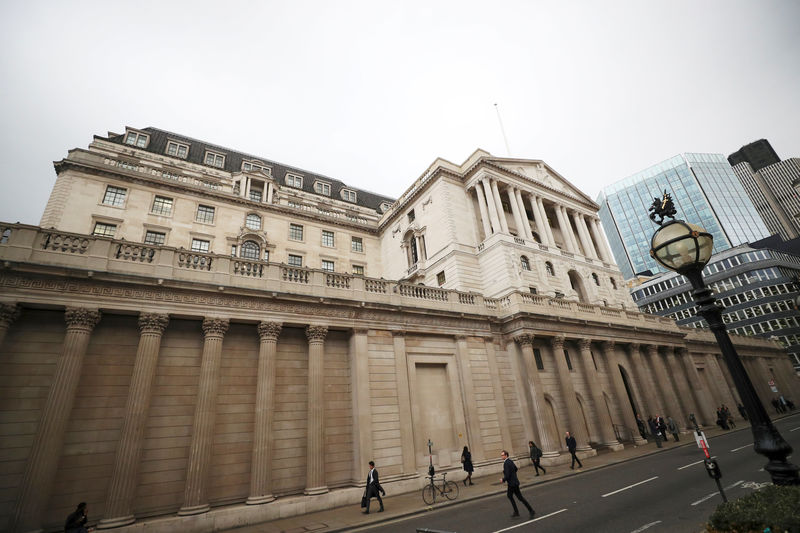 © Reuters. FILE PHOTO: People walk past the Bank of England in London
© Reuters. FILE PHOTO: People walk past the Bank of England in LondonBy David Milliken
LONDON (Reuters) – The Bank of England looks set to step into the unknown on Thursday, when it is expected to raise interest rates for the first time since 2007 at a time when growth appears weaker than before any other rate rise of the past 20 years.
Having cut rates to a record low 0.25 percent in August 2016 after Britons voted to leave the European Union, the BoE is now correcting course and falling in line with the U.S. Federal Reserve and the European Central Bank, which are either raising rates or scaling back stimulus.
Whereas the United States and the euro zone are enjoying robust growth, however, Britain’s economy has grown at its slowest pace in more than four years over the past 12 months.
Quarterly growth of 0.4 percent offers the weakest backdrop to any rate rise since the BoE became independent in 1997.
True, inflation is at a five-year high of 3.0 percent, a full percentage point above the BoE’s target, but that is mainly because the pound is an average 11 percent weaker against the currencies of Britain’s main trading partners since the Brexit vote.
The BoE has often overlooked past spikes in inflation if they were caused by currency fluctuations that were deemed to be temporary.
Inflation is set to fall this time too, but only slowly, as the BoE judges domestic inflation pressures are pending.
Partly due to stagnant productivity since the 2008 financial crisis – and partly due to concerns about the effect of Brexit on immigration, trade and investment – BoE Governor Mark Carney thinks the economy cannot grow as fast as it has in the past without generating excess inflation.
“We’re in a new paradigm,” says George Buckley, an economist at Nomura who was one of the first to sense a change at the central bank earlier this year, when most economists were saying they did not expect rates to rise until 2019.
Raising rates now would be the biggest call on monetary policy Carney has made as governor, and may shape his legacy.
Carney has faced criticism from economists who say his past guidance on monetary policy has been unhelpful, and from Brexit supporters who say he is too focused on the risks of leaving the EU. But until recently his broad approach to interest rates has been fairly uncontroversial.
For most BoE watchers, the likelihood of a rate rise only became clear in September, when minutes of the nine-member Monetary Policy Committee’s meeting that month showed underlying price pressures were no longer a minority concern.
Two policymakers voted for a rate rise, and a majority of the others said they expected to do so “over the coming months”.
RAISING RATES “MAD”
Almost all economists polled by Reuters last week expect the BoE to raise interest rates to 0.5 percent from 0.25 percent on Thursday. Most do not expect another one next year and 70 percent said even one rate rise would be a mistake. The latter view is common in markets, too.
“Personally, I think it would be mad,” Jim McCaughan, chief executive of Principal Global Investors, which manages $430 billion of assets, told Reuters earlier this month.
“You’d be tightening at a time of economic softness to defend against a weakness in sterling that you need (to boost exports).”
The BoE says its policy decisions are not driven by exchange rates. When Carney gives his news conference at 1230 GMT on Thursday, he is likely to focus on a 42-year low in unemployment and how it heralds more upward pressure on wages and inflation.
The BoE has been here before, however. Unemployment has repeatedly fallen further than the BoE forecast in recent years, while wage growth has remained stubbornly around 2 percent, half the 4 percent rate associated with pre-crisis rate rises.
Investors will be keen to glean what is meant in practice by the BoE’s long-standing stated expectation that it will only raise rates “at a gradual pace and to a limited extent”.
Markets have priced in an almost 90 percent chance of a rate rise on Thursday, but then expect the BoE to wait until late 2018 before raising again, Nomura’s Buckley said.
He said that was probably too long for the BoE’s tastes. On the other hand, however, Carney will not want to box himself in or lead the wider public to believe he plans to return rates to their pre-crisis level of around 5 percent.
Economists do not expect one or two rate rises will hurt growth much unless businesses or the public think many more will come and curb spending as a result.
BoE forecasts showing inflation is still expected to exceed its target even after three years might be the clearest sign that the BoE thinks faster rate rises are needed, Buckley said.
Either way, the stakes are high both for the BoE and its governor, who has said he will step down at the end of June 2019.
“If he presides over a tightening of monetary policy and it slows down the economy, that’s what he will be remembered for,” McCaughan said.
Source: Investing.com





























